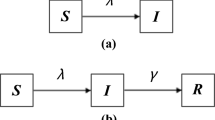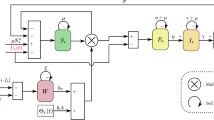Abstract
This paper proposes a new virus spreading model, susceptible–infected–susceptible–recovered–susceptible, which is based on partial immunization and immune invalidity in a complex network. On the basis of mean-field theory, the epidemic dynamics behavior of this model in a uniform network and a scale-free network is studied. After modifying the formula for the effective spread rate, we obtain the theoretical result that the coexistence of partial immunization and immune failure does not affect the network spread threshold. At the same time, the experimental results show that the existence of the above two conditions greatly increases the spread of the virus and extends the diffusion range. The study also found that in the scale-free network, peak viral infection occurs at the beginning of the spreading process, and after the immunization strategy is applied, the early infection peak is effectively curbed.







Similar content being viewed by others
References
Baagyere EY, Qin Z, Xiong H, Qin Z (2015) Characterization of complex networks for epidemics modeling. Wirel Pers Commun 83:1
Barabsi AL, Albert R (1999) Emergence of scaling in random networks. Science 286:509
Barrat A, Weigt M (2000) On the properties of small-world network models. Eur Phys J B 13:547
Boguna M, Pastor-Satorras R, Vespignani A (2003) Absence of epidemic threshold in scale-free networks with degree correlations. Phys Rev Lett 90:028701
Gandon S, Day T (2008) Evidences of parasite evolution after vaccination. Vaccine 26:54
Gianni F (2015) Evaluating complex network indices for vulnerability analysis of a territorial power grid, Journal of Ambient Intelligence and Humanized Computing. Pau Pier Luigi 6:1
Hong S, Yang H, Zhao T, Ma X (2016) Epidemic spreading model of complex dynamical network with the heterogeneity of nodes. Int J Syst Sci 47:2745
Hong T, Choi C, Shin J (2017) CNN-based malicious user detection in social networks. Concurr Comput Pract Exper. https://doi.org/10.1002/cpe.4163
Junho C, Choi C, Eunji L, Pankoo K (2015) Characterization of complex networks for epidemics modeling. New Trends Comput Collective Intell 572:195
Kermack WO, Mckendrick AG (1927) A seminal contribution to the mathematical theory of epidemics. Proc R Soc A 115:700
Kermack WO, Mckendrick AG (1938) Tests for randomness in a series of numerical observations. Proc R Soc E 138:55
Liu QM, Deng CS, Sun MC (2014) The analysis of an epidemic model with time delay on scale-free networks. Phys A 410:79
Moreno Y, Pastor-Satorras R, Vespignani A (2002) Epidemic outbreaks in complex heterogeneous networks. Eur Phys J B 26:251
Newman MEJ, Watts DJ (1999) Renormalization group analysis of the small-world network model. Phys Lett A 263:341
Newman MEJ, Moore C, Watts DJ (2000) Mean-field solution of the small-world network model. Phys Rev Lett 84:3201
Nikolaos V, Kun Y (2014) An enhanced community-based mobility model for distributed mobile social networks. J Ambient Intell Humaniz Comput 5:65
Pastor-Satorras R, Vespignani A (2000) Epidemic spreading in scale-free networks. Phys Rev Lett 86:3200
Pastor-Satorras R, Vespignani A (2001) Epidemic dynamics and endemic states in complex networks. Phys Rev E 63:066117
Sareen S, Sood SK, Gupta SK (2017) IoT-based cloud framework to control Ebola virus outbreak. J Ambient Intell Humaniz Comput 4:1–12
Shi HJ, Duan ZS, Chen GR, Li R (2009) Epidemic spreading on networks with vaccination. Chin Phys B 18:3309
Skanderova L, FabianT (2017) Differential evolution dynamics analysis by complex networks. Soft Comput 21:1817. https://doi.org/10.1007/s00500-015-1883-2
Stegehuis C, Hofstad RVD, Leeuwaarden JSHV (2016) Epidemic spreading on complex networks with community structures. Sci Rep 6:29748
Wang YQ, Jiang GP (2010) Virus spreading on complex networks with imperfect immunization. Acta Phys Sin 59:6734
Wang J, Zhao L, Huang R (2014) SIRaRu rumor spreading model in complex networks. Phys A 398:43
Watts DJ, Strogatz SH (1998) Collective dynamics of ’small-world’ networks. Nature 393:440
Yang L, Qiao Y, Liu Z, Ma J, Li X (2016) Identifying opinion leader nodes in online social networks with a new closeness evaluation algorithm. Soft Comput. https://doi.org/10.1007/s00500-016-2335-3
Yun-Peng Xiao, Song-Yang Li, Yan-Bing Liu (2017) An information diffusion dynamic model based on social influence and mean-field theory. Acta Phys Sin 66:030501
Yu F, Xia X, Li W, Tao J, Ma L, Cai Z (2016) Critical node identification for complex network based on a novel minimum connected dominating set. Soft Comput 21:5621. https://doi.org/10.1007/s00500-016-2303-y
Acknowledgements
This paper is supported by the National Natural Science Foundation of China (Grant Nos. 61671202, 61573128, 61273170), the National Key Research and Development Program of China (Grant No. 2016YFC0401606) and the Fundamental Research Funds for the Central Universities of Ministry of Education of China (Grant No. 2015B25214). This study was funded by Xuewu Zhang (Grant Nos. 61671202, 61573128, 61273170, 2016YFC0401606, 2015B25214).
Author information
Authors and Affiliations
Corresponding author
Ethics declarations
Conflict of interest
The authors declare that they have no conflicts of interest to this work.
Ethical approval
This article does not contain any studies with human participants or animals performed by any of the authors.
Additional information
Communicated by A. Di Nola.
Rights and permissions
About this article
Cite this article
Zhang, X., Wu, J., Zhao, P. et al. Epidemic spreading on a complex network with partial immunization. Soft Comput 22, 4525–4533 (2018). https://doi.org/10.1007/s00500-017-2903-1
Published:
Issue Date:
DOI: https://doi.org/10.1007/s00500-017-2903-1




